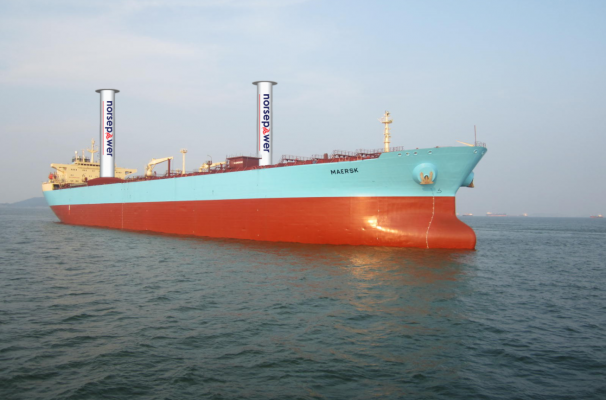The rotor sails will be fitted to a tanker and are expected to save approximately 10% in fuel consumption and associated emissions
A tanker is to be fitted with ‘rotating sails’ which could pave the way for greener ship movements around the globe.
One of the world’s biggest shipping lines, Maersk Tankers, will be outfitting one of its tankers with two 30-metre tall by 5-metre diameter Norsepower Rotor Sails.
This is the first time such sails have been used on a vessel of this size, and it is hoped it will cut down on fuel costs.
The project is being run by the Finnish company Norsepower Oy Ltd. in partnership with Maersk Tankers, The Energy Technologies Institute (ETI), and Shell Shipping & Maritime.
The Norsepower Rotor Sail Solution is a modernised version of the Flettner rotor – a spinning
cylinder that uses the Magnus effect to harness wind power to propel a ship.
It was invented by German engineer Anton Flettner, and the first ship to use the technology, the Buckau, was built in October 1924.

The Buckau. Credit: Wikimedia Commons
The refitted schooner carried two rotors approximately 15 metres high, and 3 metres in diameter and were driven by an electric propulsion system of 50 hp.
In 1926, a larger ship with three rotors, the Barbara, was built by the shipyard A.G. Weser in Bremen.
The Buckau, which was eventually renamed the Baden Baden, completed a number of voyages, but the Flettner system was eventually shelved for being uneconomical.
Video & Pictures: World’s first full scale ship tunnel to be built in Norway
The programme manager HDV marine and offshore renewable energy at The Energy
Technologies Institute (ETI), Andrew Scott, explained the potential benefits of using the rotor sails.
“Flettner rotors have the potential to reduce ship fuel consumption substantially, especially on tankers and dry bulk carriers,” he said.
“It is one of the few fuel saving technologies that could offer double digit percentage improvements. To date, there has been insufficient full scale demonstration on a suitable ocean going marine vessel to prove the
technology benefits and operational impact,” he continued.
“Demonstrating the technology in this project will make it more attractive to shipping companies and investors, and could play a significant role in reducing the fuel costs and improving the environmental impact of shipping in the future,” added Scott.
The Norsepower Rotor Sails will be fitted to the Maersk Tanker during the first half of 2018, before undergoing testing and data analysis at sea until the end of 2019.
The Finnish company says each Rotor Sail is made using the latest intelligent lightweight composite sandwich materials, and offers a simple yet robust hi-tech solution.
When wind conditions are favourable, the main engines can be throttled back, providing a net fuel cost and emission savings, while not impacting scheduling.
Independent experts will analyse the data gathered from the project before publishing technical and operational insights, and performance studies.
MDL Marinas creates custom pontoons for Land Rover BAR
Land Rover BAR's official marina partner, MDL Marinas, has built customised pontoons for the America's Cup team in Bermuda
Boaty McBoatface returns home after successful Antarctic mission
The bright yellow Boaty McBoatface submersible has arrived back in Southampton after taking part in its first Antarctic mission





